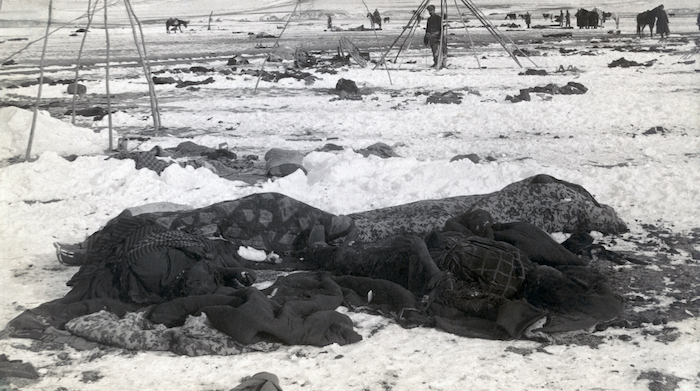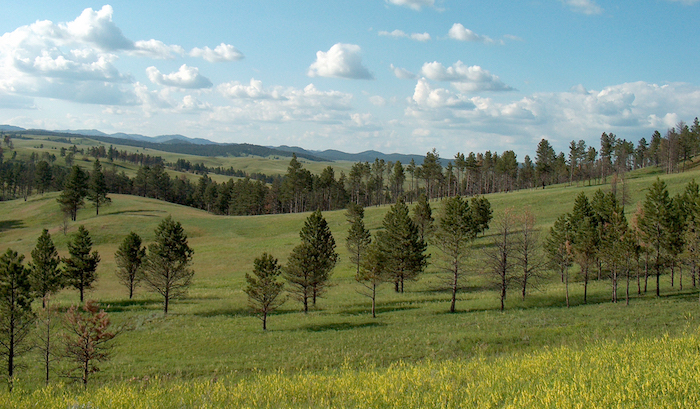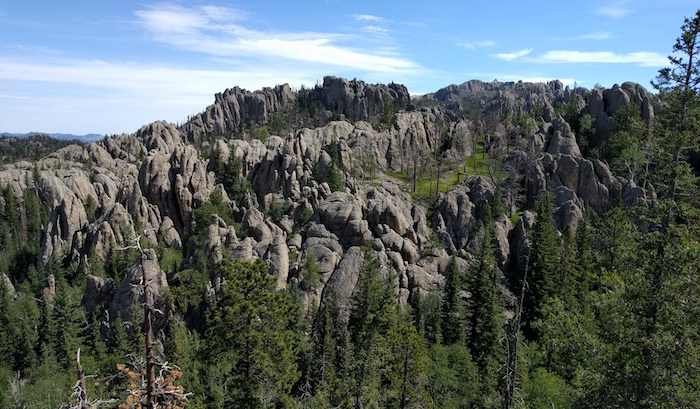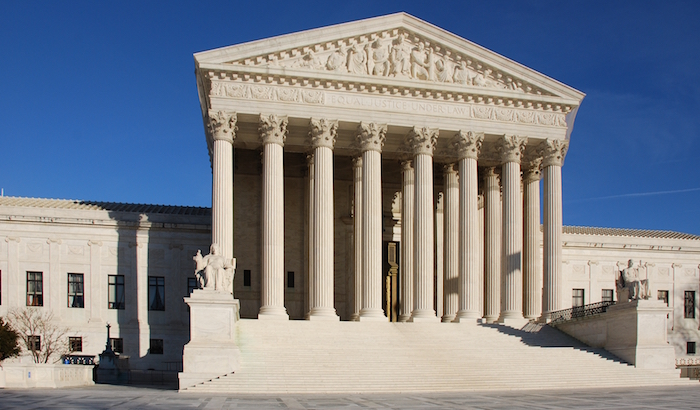Legal dramas are an enormously popular genre, but they effectively don’t exist in the RPG space. Who has five friends with enough knowledge of the law to improvise a good episode of The Practice? Who can ad lib a twenty-minute opening argument that doesn’t make the other players claw their eyes out? The key is to move the legal drama out of the courtroom, into spaces RPGs handle better. For this piece, I’ll use a fascinating, high-stakes legal case: the argument by the Lakota nation that the U.S. government’s seizure of their land was illegal.

First, a couple paragraphs of history, since it’s important to the case. The Lakota are a Native American Sioux nation who lived in and around the Black Hills of South Dakota when sustained contact with whites began. The Lakota knew from the experiences of their Dakota cousins to the east and the Cheyenne to the south that the U.S. government would someday come for their land. The Black Hills were (and remain) sacred to the Lakota, so protecting those hills from federal encroachment was a top priority.
Worse, the Lakota knew the Black Hills were full of gold. In 1857, following federal violations of the treaty of 1851, a Lakota council decreed they’d kill any Native who told a white man about the gold. By keeping the metal secret, they hoped to tamp down white interest in their sacred hills. Nonetheless, word got out via Army scouts and fur trappers. An 1874 illegal military expedition into the Black Hills by George Custer confirmed the stories. Within months, white prospectors began rushing in. This was a violation of an 1868 treaty (and therefore federal law), but the Army did little to stop these prospectors.
Federal actions were complicated by inconsistent white attitudes towards Natives. Some advocated for cultural genocide, assimilating Indians into white culture and leaving no trace of Indian culture. This was the “kill the Indian and save the man” attitude of the infamous Carlisle schools. Other whites advocated for literal genocide: killing every man, woman, and child who resisted, and letting the rest starve to death on barren-soiled reservations. One of the most influential advocates for literal genocide was the head of the U.S. Army, General William Sherman, famous for ‘Sherman’s march to the sea’ in the Civil War. Almost no non-Natives advocated for just leaving the Lakota alone.
In 1875, the federal government offered to buy the Black Hills from the Lakota for $6 million. The Lakota refused, and began organized attacks on the 4,000 miners illegally squatting on their land. The Army was hoping this would happen. Soldiers rushed in to defend the miners. The government ultimately won the Great Sioux War, despite a Native victory at the Battle of Little Bighorn. There would be further conflicts, most notably the Army’s murder of 300 noncombatants at Wounded Knee in 1890. But as the last free Lakota were shuffled off to reservations, the issue of federal ownership of the Black Hills seemed settled.

With control of their sacred hills out of their grasp, the Lakota instead sought a more practical option: financial compensation for the land taken from them by the sword. Because they were denied citizenship (the 14th Amendment didn’t apply to Natives), the Lakota first had to convince Congress to repeal legislation that barred them from suing the federal government. That exemption had to wait until 1920, after 16,000 Natives fought in WWI, at a rate twice that of the enfranchised civilian population. Native sacrifices on behalf of a country that didn’t even want them convinced Congress that the Lakota deserved at least a small subset of the civil rights white Americans took for granted.
Once begun, the case moved painfully slowly and had to be restarted several times following new legislation. Our interest in it begins in 1957, when a new team of lawyers for the Lakota nation argued the previous lawyer had been so incompetent his unsuccessful cases, motions, and appeals should be thrown out and the case tried anew. The U.S. Court of Claims agreed and re-heard the case.
At this point, I’m going to start inserting comments about how to use this case as a template for legal adventures at your table. The idea is not that your PCs will litigate United States v. Sioux Nation of Indians. Rather, you can use it as a template for a high-profile case in your fictional campaign setting and see where your PCs can fit in and do awesome things!
The argument the Lakota’s lawyers used in 1957 was that the government’s seizure of Lakota land without remuneration was a violation of the 5th Amendment which requires “just compensation” if “private property be taken for public use”. Determining the value of the land when it was seized took extensive historical research. This is a great job for PCs, letting them travel all over the disputed territory making surveys, talking to old people, visiting archives, and probably having to overcome obstacles thrown up by the companies that have profited off the land, local governments leery of helping their less-fortunate neighbors, and maybe even vigilantes (if things are really ugly).
The government’s response to this new case was just to point over and over again to previous cases where the court ruled against the Lakota. The government’s unwillingness to talk about the substantive facts of the case was smart, but it dragged the process to a crawl. By the time the court was able to issue a ruling, it was 1974. This “procedural sparring” is a great way for the PCs to get involved: forcing government bureaucrats do their damn job and talk in court about what’s in the law and in history. The party could publicize in the papers the bureaucrats’ refusal to cooperate. They might put pressure on the political appointees that run their departments. PCs could even call in favors to have the worst offenders shuffled off to punishment assignments.

The 1974 ruling for the first time acknowledged the government’s repeated treaty violations and illegal machinations to seize the Black Hills. Thus, since the seizure occurred outside legal processes and the Lakota weren’t compensated, the government’s actions violated the 5th Amendment. The court ruled the Black Hills were worth $17.1 million when seized, and the Lakota were owed that, plus a century of 5% annual interest, for a total of about $100 million. However, the government might be entitled to deduct its expenditures on Lakota reservations since that date, likely reducing the payout to almost nothing.
The Lakota’s lawyers found a clever way to get around this obstacle. Before further hearings could establish the final amounts due, the lawyers changed the rules. They found a sympathetic senator to push through a law amending the court’s mandate to exclude reservation payments from its calculus. At your table, finding a sympathetic lawmaker is a great task for the PCs. And if all the party’s inquiries come to naught, they can make one! The party can either dig up dirt on a current senator and blackmail her, or throw their support behind a candidate and ensure she wins.

But all this litigation wasn’t occurring in a vacuum. A new sense of self-determination and sovereignty was sweeping the Lakota nation. There was a growing sense among many Lakota that they shouldn’t be asking for compensation. They should be asking for their damned land back! If the Lakota accepted a payout, the thought went, the Black Hills would be sold, and thus well and truly gone. Other Lakota felt the Black Hills were out of reach, and a cash payout was better than nothing.
This dispute mixed with a political split among the Oglala Lakota, the tribe most associated with the Black Hills and the court case. Following the 1934 Indian Reorganization Act, the Oglala established a democratically-elected tribal government, something foreign to Sioux tradition. The government came to be dominated by better-off, mixed-race Oglala, while many of the poorer, ‘full-blooded’ Oglala boycotted the new government as illegitimate. The tribal government intimidated and may have killed anti-government traditionalists to stay in power. This traditionalist faction was often aligned with the sovereignty-focused, pan-Native, American Indian Movement (AIM).
In 1973, the sovereignty faction and AIM occupied the village of Wounded Knee (beside the site of the 1890 massacre) on the Oglala reservation. The tribal government called in federal troops. During the resulting siege, the sovereignty faction demanded interactions between the Oglala and the federal government be based on the 1868 treaty, the last one the Lakota signed of their own free will – and which granted them the Black Hills. Federal troops killed two activists (one Cherokee, one Oglala) and ended the siege.

This Oglala political split had huge implications for the court case. A growing number of Lakota didn’t support the case anymore, as they believed it didn’t go far enough. Even while the sympathetic senator was arguing for pro-Lakota legislative changes, an Oglala religious leader representing the sovereignty faction testified before Congress that his organization actually opposed the proposed legislation.
This political fissure fields amazing opportunities for PCs. In your campaign setting with its fictional court case, the PCs will have to decide which side to back. Even saying “we’re going to stay out of this” implicitly sides with the tribal government and the pro-compensation faction against the sovereignty faction. If the party switches to the side that opposes the case, they will bring a wealth of knowledge on the ins and outs of the case and how best to bring it down. If the PCs stay with the pro-compensation faction, the lawyers may dispatch them to bedevil the sovereignty faction and keep the case steaming ahead.
The stakes only increased over the next decade. There was more procedural sparring. The government appealed. The pro-compensation faction got their senator to drive through more favorable legislation. In 1980, the Supreme Court ruled in favor of the Lakota and awarded them $105 million.
Then the sovereignty faction dropped a bombshell: the Lakota’s hot-shot lawyers had failed to renew their contract three years ago. They hadn’t had the right to represent the Lakota before the Supreme Court. The sovereignty faction fielded their own lawyer, an Oglala Lakota named Mario Gonzalez, who sued the federal government for the return of the Black Hills and $11 billion in damages.

Image credit: Jarek Tuszyński. Released under a CC BY-SA 3.0 license.
Gonzalez’s several suits never saw much success, but they weren’t really meant to. The point was not to overturn the existing rulings, but to bolster American public sentiment that the Lakota were wronged and should have the Black Hills returned to them. The sovereignty faction is playing the long game. They know they won’t get the Black Hills back today, but if they keep influencing popular opinion, they may get them back next century, or even next millennium. Similar strategies have succeeded for the Alaska Natives, Taos, Penobscots, and Passamaquoddies. In the interim, the Lakota sovereignty faction is willing to wait.
In your campaign setting, your fictional court case may end very differently. If your characters work against your Gonzalez-analogue, they may stop him before he gets started. Alternately, if they support him, they might drive some of his cases to actual success, perhaps through legislative change, sabotaging the opposing lawyers, or discovering long-forgotten historical details.
In real life, the Lakota have never accepted their payout. Doing so, many feel, would ‘sell’ the Black Hills to the government and spoil the Lakota’s chances to ever get the hills back. Instead, some Lakota are quietly buying land in the Black Hills. The Lakota won’t sell their sacred lands, but buying them back piecemeal is a whole other matter. The payout sits untouched in a trust, continuing to draw interest, and is now over $1 billion in size.
–
Sources:
The Lakota and the Black Hills: the Struggle for Sacred Ground by Jeffrey Ostler (2010)
Bury My Heart at Wounded Knee: An Indian History of the American West by Dee Brown (1970)






